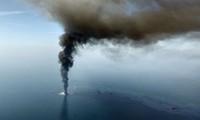 Just days after the unfolding oil-related environmental disaster started in the Gulf of Mexico, a number of Democratic lawmakers began lobbying the US government to quickly get involved in approving an offshore wind farm industry.
Just days after the unfolding oil-related environmental disaster started in the Gulf of Mexico, a number of Democratic lawmakers began lobbying the US government to quickly get involved in approving an offshore wind farm industry.
“Fossil fuels are just not sustainable over the long run for all sorts of reasons,” Rush Holt, a representative from New Jersey, was quoted as saying by AFP.
Holt and three other New Jersey lawmakers were responding to BP’s Deepwater Horizon spill which started after an April 20 explosion killed 11 oil workers, unleashing at least 200,000 gallons of oil a day into ocean waters now drifting towards Louisiana, Mississippi, Alabama and Florida.
Some analysts are saying the Gulf spill — which occurred just weeks after President Barack Obama said he was expanding offshore oil drilling — has the potential of becoming the worst oil disaster in US history and a far greater ecological nightmare that the Exxon Valdez tanker spill that dumped 11 million gallons of crude off Alaska’s shores in 1989.
At a press conference, Holt and the other lawmakers said developing an offshore wind industry can be a viable alternative to drilling for oil in the ocean. “The wind resources are really quite large and over time are much larger than oil resources,” AFP quoted him saying, adding offshore wind power could supply “more than half of the electricity need of the eastern United States.”
Putting the looming disaster into perspective, New York Times columnist Paul Krugman noted Monday that “the gulf blowout is a pointed reminder that the environment won’t take care of itself, that unless carefully watched and regulated, modern technology and industry can all too easily inflict horrific damage on the planet.”
An article in the Observer noted that another oil company, Shell, has noted a steady increase in both hazardous waste and non-hazardous waste. Moreover, the article says that Shell is using a quarter more energy to find and produce each barrel of oil than it did a decade ago.







 Comments
Comments
